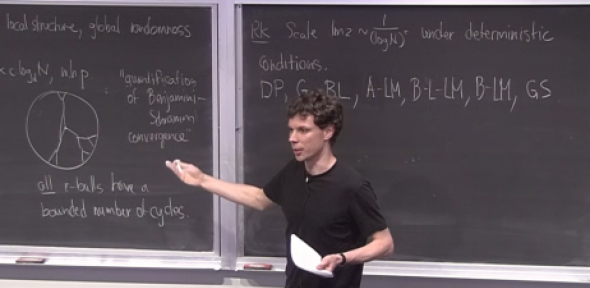
Roland Bauerschmidt works on problems motivated by physics. But he is not in the Department of Physics, nor is he in the Department of Applied Mathematics and Theoretical Physics. Rather, Bauerschmidt is a Reader in the Statistical Laboratory of the Department of Pure Mathematics and Mathematical Statistics.
Bauerschmidt was always interested in maths at school, and then took the opportunity to study physics at university. "I was most fascinated by the questions that you didn't need to go to the lab to [explore]," he says. He now works in one such area, researching systems involving a very large number of simple particles that interact with each other in a simple way. Starting from this simple microscopic description, he is interested in understanding the collective macroscopic behaviour.
Changing phases
An example we are all familiar with is water. At small scales water consists of many water molecules, and each molecule interacts only with its nearby neighbours. "But if you look at all the molecules together you see these fascinating and complicated phenomena, from ice, gas, and water to waves." These behaviours of water, however, are actually far too difficult to be understood from mathematical descriptions of individual molecules and their interactions.
"It's fascinating to me to see how such a simple description can lead to such complicated and profound behaviour."Roland Bauerschmidt
Instead, Bauerschmidt studies simpler systems, such as spin systems, which can be thought of as a model of a magnet. Spin systems have similar fascinating macroscopic behaviours to water: "If you have a magnet in a fridge, and then you put it in the oven, you’ll see the magnetisation go away. This is similar to the case of [ice melting]." If you heat ice it changes phase from solid to liquid; you get a similar phase transition if you heat a magnet.
Bauerschmidt works with simplified models of these systems that still exhibit the kind of phenomena, like phase transitions, that he'd like to understand. "It's fascinating to me to see how such a simple description can lead to such complicated and profound behaviour," he says. In this way he's bringing a mathematical perspective to these problems, rather than trying to specifically model or predict what is happening in a lab. "[By studying] the simplest context where these behaviours arise, you see what is needed to make these phenomena happen."
Dealing with too much information
This is why Bauerschmidt is a member of the Statistical Laboratory. The systems he studies have so many particles that it's impossible to exactly describe the position and behaviour of each and every particle. Instead, he uses probability models arising from physics describing how the particles are distributed in space. "You have the distribution of the positions of, say, 1023 particles. We don't want to know where every single particle is, that is way too much information to make any sense of. The question is to extract the large scale behaviour."
"Although the overarching field is concerned with distributions, these kinds of questions can be approached with different mathematical methods. My primary method is analysis – differential equations and other methods of analysis. But problems in the same class can be studied using combinatorial methods. There's a wide variety of methods that are useful, and that is one of the nice aspects of this field."
Variety is also what Bauerschmidt enjoys about working in the Maths Faculty. Bauerschmidt can interact with lots of colleagues from related areas, and he appreciates the freedom to explore different research directions he is interested in. He also enjoys working with the students at Cambridge: "There are really good students, and it's always rewarding to get them interested in a problem or work with a graduate student on something related to your work."
You can discover more about the intersections between physics and pure mathematics by watching this lecture by David Tong, Professor of Theoretical Physics at DAMTP, and in this interview with Dr Claude Warnick.
